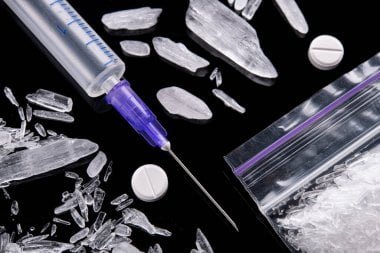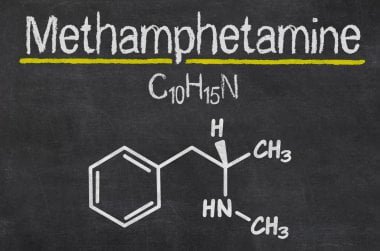Table of Contents
How long Does Meth stay in Your System: Comprehensive Guide
What is meth Methamphetamine
Methamphetamine, commonly known as meth, is a powerful and highly addictive central nervous system stimulant. It is chemically similar to amphetamine, but has stronger effects on the mind and body. Here is a detailed review:

1. Chemical Composition

Chemical Formula: C10H15N
Structure: Methamphetamine is a synthetic compound with a similar structure to amphetamine, which affects neurotransmitter levels in the brain.
2. Forms and Methods of Use
Methamphetamine can be found in several forms
- Powder: usually white or off-white, crystalline powder that can be eaten, snorted or injected.
- Crystal Meth: Known as “Crystal Meth”, this form consists of clear crystals or blue rocks and is commonly smoked.
- Pills: Methamphetamine is also available in pill form, often sold as “Ecstasy” or “MDMA”.
3. Effects on the Body
Methamphetamine has a range of effects on both the mind and body:
- Short Term Effects: Increased heart rate, increased blood pressure, hyperthermia (increased body temperature), heightened alertness, euphoria, and decreased appetite.
- Long-Term Effects: Chronic use can cause severe dental problems (often called “meth mouth”), extreme weight loss, skin lesions, and significant cognitive deficits. Long-term use also increases the risk of mental health problems such as paranoia, hallucinations, and violent behavior.
4. Procedure
Methamphetamine increases the levels of certain chemicals in the brain:
- Dopamine: Methamphetamine causes the release of large amounts of dopamine, a neurotransmitter associated with pleasure and movement. This increase in dopamine levels is associated with the intense pleasure experienced during use as well as its addictive properties.
5. Addiction and Dependence

Methamphetamine is highly addictive because of its powerful effects on the brain’s reward system:
- Tolerance: Users may develop tolerance, requiring higher doses to achieve the same effects.
- Dependence: Regular use can lead to physical and psychological dependence, which makes it difficult for users to quit without professional help.
6. Treatment and recovery
Treatment for methamphetamine addiction usually includes a combination of:
- Behavioral Therapy: Programs such as Cognitive Behavioral Therapy (CBT) help individuals change their drug use behaviors.
- Support Groups: Groups such as Narcotics Anonymous (NA) offer peer support.
- Medical Intervention: In some cases, medication may be used to manage withdrawal symptoms or accompanying mental health conditions.
7. legal status
Methamphetamine is classified as a Schedule II controlled substance in the United States, indicating that it has a high potential for abuse without an acceptable medical use for the non-medical user.
Understanding the effects of methamphetamine on the body and mind underscores the importance of prevention and treatment efforts to address addiction and its associated health risks.
How long does Meth stay in your system
Methamphetamine can remain in the body for varying lengths of time depending on a variety of factors, including the type of drug test used, frequency of use, dosage, metabolism, and overall health of the individual. Here is a general overview:
- 1. Urine Test: Methamphetamine can usually be detected in urine 1 to 4 days after use. In chronic users, it may be detectable for a week or more.
- 2. Blood Test: Methamphetamine is usually detectable in the blood for 1 to 3 days.
- 3. Saliva Test: In saliva, methamphetamine can be detected for approximately 1 to 4 days.
- 4. Hair Test: Hair tests can detect methamphetamine for up to 90 days, usually up to 90 days, or even longer in some cases, depending on hair length and growth rate.
These detection windows are approximate and may vary based on individual factors such as metabolic rate, body mass, and overall health.
What Are the Implications of Second-Hand Meth Smoke?
Secondhand methamphetamine smoke, similar to secondhand tobacco smoke, can have many health implications, especially because meth smoke contains toxic and harmful chemicals. Implications of exposure to secondhand meth smoke include:
1. Health Hazards for Non-Smokers
- Respiratory Problems: Exposure to secondhand meth smoke can cause respiratory problems, including lung irritation, coughing, and difficulty breathing. The toxic chemicals in meth smoke can aggravate conditions like asthma and bronchitis.
- Cardiovascular effects: Chronic exposure may increase the risk of cardiovascular problems due to the presence of harmful substances affecting the function of the heart and blood vessels.
- Neurological Effects: Long-term exposure to secondhand meth smoke can affect brain function, possibly leading to cognitive deficits or neurological symptoms similar to those seen in meth users.
2. Effects on Children
- Developmental Effects: Children exposed to secondhand meth smoke may experience developmental problems, including problems with cognitive and motor skills. Their developing bodies and brains are more vulnerable to the toxins in smoke.
- Increased risk of health conditions: Children are at higher risk of respiratory infections, asthma exacerbations, and other health problems due to smaller airways and higher breathing rates.
3. Environmental Pollution
- Residue: Meth smoke can leave a residue on surfaces like walls, floors and furniture. These residues can be harmful if ingested or inhaled, especially by children and pets.
- Cleanup Challenges: Cleaning up residual meth contamination can be difficult and expensive. This often requires professional remediation to ensure the environment is safe to operate again.
4. Legal and Social Implications
- Regulations: Some jurisdictions have regulations and laws regarding the cleaning and decontamination of properties used to manufacture or smoke methamphetamine. Failure to comply with these regulations may lead to legal consequences.
- Social Impact: The presence of meth smoke residue can denigrate properties, affect property values and potential for rent or sale. It can also affect relationships between communities and families.
5. Precautions
- Ventilation: Ensuring good ventilation in areas where methamphetamine is smoked can help reduce the concentration of harmful chemicals in the air.
- Cleaning: Regular cleaning and, if necessary, professional decontamination can help reduce the residual risks of meth fumes.
Overall, the implications of secondhand meth smoke are significant and can pose serious health risks to both individuals and their environment. Awareness and appropriate measures are essential to reduce these risks.
Meth Withdrawal
Methamphetamine withdrawal occurs when someone who has been using meth regularly stops or significantly reduces their use. The withdrawal process can be difficult and the severity varies depending on the individual’s level of dependence and history of use. Here’s a closer look at Math’s comeback:
1. Meth Withdrawal Symptoms
Early symptoms (1-3 days)
- Fatigue: Users often experience extreme fatigue and lethargy.
- Depression: Mood swings and feelings of sadness or hopelessness are common.
- Increased Appetite: Appetite and food cravings may increase significantly.
- Sleep Disturbance: Difficulty falling asleep or excessive sleep may be experienced.
Severe symptoms (1-2 weeks)
- Strong Cravings: The strong desire to use meth again can be overwhelming.
- Irritability and mood swings: Emotional instability and agitation are common.
- Difficulty concentrating: Users may struggle with attention and cognitive tasks.
- Physical Discomfort: Muscle aches, headaches, and general discomfort are common.
Prolonged symptoms (several weeks to months)
- Persistent depression: Persistent feelings of sadness or depression may persist beyond the acute withdrawal phase.
- Anxiety and Anxiety: Some individuals may experience ongoing anxiety or paranoia.
- Cognitive Problems: Long-term cognitive impairments, such as memory problems, may persist.
- cravings: Cravings for meth may persist, which increases the risk of relapse.
2. Meth’s Return Timeline
- Early Phase: Withdrawal symptoms usually begin within 24 to 48 hours after the last use of meth.
- Peak Phase: Symptoms usually reach their peak within 1 to 2 weeks.
- Recovery Phase: Most acute symptoms resolve within 1 to 3 weeks, but some psychotic effects and cravings may persist for months.
3. Meth Withdrawal Treatment
Medical Supervision
- Detoxification: In some cases, medical detoxification may be necessary to manage severe symptoms and ensure safety.
- Medications: Although there are no specific medications approved for meth withdrawal, doctors may prescribe medications to help manage symptoms such as depression or anxiety.
Behavior Therapy
- Cognitive-Behavioral Therapy (CBT): Helps individuals develop coping strategies and deal with negative thought patterns.
- Motivational Interviewing: Encourages commitment to change and reinforces motivation to remain drug free.
Support System
- Counseling: Individual or group counseling can provide emotional support and practical advice.
- Support Groups: Participation in groups such as Narcotics Anonymous (NA) can offer peer support and shared experiences.
Lifestyle Changes
- Healthy Diet: A balanced diet can help increase appetite and support overall health.
- Regular Exercise: Physical activity can improve mood and reduce stress.
- Good sleep hygiene: Establishing a regular sleep routine can help with sleep disturbances.
4. Challenges and Considerations
save again
- Triggers: Identifying and avoiding triggers that may trigger a relapse.
- Continued Support: Continued participation in therapy and support groups can help maintain sobriety.
Long Term Rehabilitation
- Holistic Treatment: A holistic approach that addresses both the physical and psychological aspects of addiction often produces the best results.
- Monitoring: Regular check-ins with health care providers or counselors can help track progress and adjust treatment as needed.
Methamphetamine withdrawal can be a difficult process, with symptoms ranging from fatigue and depression to severe cravings and cognitive problems. Effective treatments usually include medical supervision, behavioral therapy, and support systems. Understanding the timeline and symptoms of withdrawal, along with access to appropriate resources, is essential to successful recovery and long-term sobriety.
How to Get Meth Out of Your System
Getting methamphetamine out of your system is basically a matter of allowing your body to metabolize and eliminate the drug naturally. However, there are several strategies and practices that can support and potentially accelerate this process. Here’s a comprehensive guide on how to help your body cleanse methamphetamine:
1. IMMEDIATE ACTIONS
Hydration
Drink plenty of water: Staying well hydrated helps flush toxins from your system and supports overall kidney and liver function. Try to drink at least 8-10 glasses of water daily.
healthy diet
- BALANCED DIET: Eating a nutritious diet rich in fruits, vegetables, lean proteins and whole grains supports your body’s natural detoxification process.
- Avoid caffeine and alcohol: These substances can dehydrate you and interfere with your body’s ability to eliminate toxins.
Relax
Adequate Sleep: Make sure you get enough rest to help your body’s recovery and natural detoxification. Aim for 7-9 hours of quality sleep each night.
2. Supportive Measures
exercise
- Regular Physical Activity: Regular exercise can increase your metabolism and improve overall health, helping to eliminate methamphetamine from your system. Aim for at least 30 minutes of moderate exercise most days of the week.
Use Sauna
- Sweating: Using a sauna can promote sweating, which can help flush out toxins through the skin. However, it’s important to stay hydrated and consult a healthcare professional before using the sauna, especially if you have a medical condition.
Medical Supervision
- CONSULT A HEALTHCARE PROVIDER: Seek medical advice if you experience severe withdrawal symptoms or if you have concerns about the detoxification process. A health care provider can offer guidance and recommend specific treatments or therapies.
3. Detoxification Strategies
Detox Program
- Professional Detoxification: In some cases, enrollment in a medically supervised detox program may be necessary, especially for people with severe addictions or health complications. Detox programs provide medical support and a structured environment to safely manage withdrawal symptoms.
Behavior Therapy
- Advice and Treatment: Engaging in behavioral therapies such as Cognitive Behavioral Therapy (CBT) can help address the psychological aspects of addiction and aid in recovery.
Support Groups
- Peer Support: Joining support groups, such as Narcotics Anonymous (NA), can provide encouragement and shared experiences, which can be beneficial during the detoxification process.
Clearing methamphetamine from your system involves a combination of natural detoxification processes supported by hydration, proper nutrition, exercise and rest. For those with severe addictions or health concerns, professional detoxification and medical supervision may be necessary. Understanding detection windows and using supportive strategies can aid in the process of detoxifying and improving overall health.
How long does it take to become addicted to meth?
Methamphetamine is a highly addictive stimulant, and the timeline for developing addiction can vary widely between individuals. A number of factors influence the speed at which addiction can develop, including frequency of use, dosage, individual susceptibility, and underlying mental health. Here’s a detailed look at how methamphetamine addiction can develop:
1. Factors Affecting the Development of Addiction
Frequency and Method of Use
- Rapid Onset: The effects of methamphetamine can be intense and euphoric, especially when smoked or injected. These methods lead to a rapid onset of effects, which can increase the risk of rapid addiction.
- Regular use: Repeated use of methamphetamine increases the likelihood of addiction. Individuals who use the drug daily or several times a week are at greater risk of developing dependence quickly.
Diet and Purity
- High Doses: Using large amounts of methamphetamine can increase the risk of addiction. The intensity of the drug’s effects can reinforce the desire to continue using it.
- Drug Purity: High purity methamphetamine can produce more pronounced effects, possibly accelerating the development of addiction.
Individual sensitivity
- Genetic Factors: Some individuals may have a genetic predisposition to addiction, making them more susceptible to developing dependence on methamphetamine.
- Mental health conditions: Co-occurring mental health problems, such as depression or anxiety, can increase the risk of addiction.
Environmental and Social Factors
- PEER INFLUENCE: Social environment and peer pressure can contribute to the speed at which addiction develops. People surrounded by other people who use methamphetamine may be at greater risk.
- Stress and Trauma: High levels of stress or past trauma can contribute to a higher risk of addiction, as people may use methamphetamine as a coping mechanism.
2. Timeline of Addiction Development
Initial Use
- Immediate Effects: The euphoric effects of methamphetamine are often experienced immediately after use, which can create a strong positive reinforcement and increase the desire to use the drug again.
Short Term Use
- Increases tolerance: Regular use of methamphetamine can lead to the rapid development of tolerance, meaning that increasing amounts are needed to achieve the same effects. This can accelerate the cycle of use and dependence.
Dependence and Addiction
- rapid development: For some individuals, addiction can develop within a few weeks of regular use due to the drug’s powerful reinforcing effects.
- Long-term use: For others, it may take several months of continuous use before addiction fully develops. Chronic use often leads to physical and psychological dependence.
3. Signs of Addiction
Physical Signs
- Increased tolerance: More of the drug is needed to achieve the same effects.
- Withdrawal Symptoms: Experiencing physical and psychological symptoms when not using methamphetamine.
Behavior Signs
- Compulsive Use: Persistent desire to use methamphetamine despite negative consequences.
- Neglecting Responsibilities: Prioritizing drug use over work, relationships and personal care.
psychotic symptoms
- cravings: a strong and frequent desire to use methamphetamine.
- Preoccupation: Spending a lot of time thinking about or planning drug use.
The timeline for developing methamphetamine addiction can vary based on several factors, including frequency of use, dose, individual sensitivity, and environmental influences. Addiction can develop quickly, especially with frequent and high doses, but may take months of continuous use to fully manifest. Recognizing the signs of addiction and seeking professional help are critical to effective treatment and recovery.
Overall Results on Methamphetamine
Methamphetamine is a powerful and highly addictive stimulant that significantly affects the central nervous system, resulting in intense excitement, increased energy and increased alertness. Its effects, which can last for 6 to 8 hours, can cause severe short-term and long-term consequences for users.
Methamphetamine addiction can develop rapidly, especially with repeated and high-dose use. The speed at which addiction forms is affected by a variety of factors, including route of use, dose, individual susceptibility, and Environmental effects. For some people, addiction can begin within weeks of regular use, while others can develop dependence over several months.
Methamphetamine withdrawal involves a variety of symptoms including fatigue, depression, increased appetite, sleep disturbances, and cravings. The withdrawal process usually begins within 1-3 days after the last use, lasts about 1-2 weeks, and can involve prolonged symptoms from several weeks to months. Effectively managing withdrawal often requires medical supervision, behavioral therapy, and a support system.
Clearing methamphetamine from the body involves a combination of natural detoxification and supportive measures. Staying hydrated, eating a nutritious diet, engaging in regular exercise, and ensuring adequate rest are important steps. Detoxification can be supported by professional programs if necessary, and understanding the detection windows for various tests (urine, blood, saliva, and hair) helps individuals and health care providers systemize It helps in detecting the presence of drugs.
Effects of secondhand smoke are also important, as it can cause health problems in non-smokers, including respiratory problems, cardiovascular effects, and pollution of the living environment. Addressing the dangers associated with methamphetamine involves not only treating those who use the drug, but also managing environmental impacts to protect those around them.
In summary, methamphetamine poses serious risks of addiction and health complications. Effective management and recovery from methamphetamine use requires a comprehensive approach that includes medical treatment, behavioral therapy, and ongoing Help is involved. Recognizing the signs of addiction, understanding the effects and withdrawal process, and getting appropriate help are essential steps to recovery and improving overall health. Read more about your health

